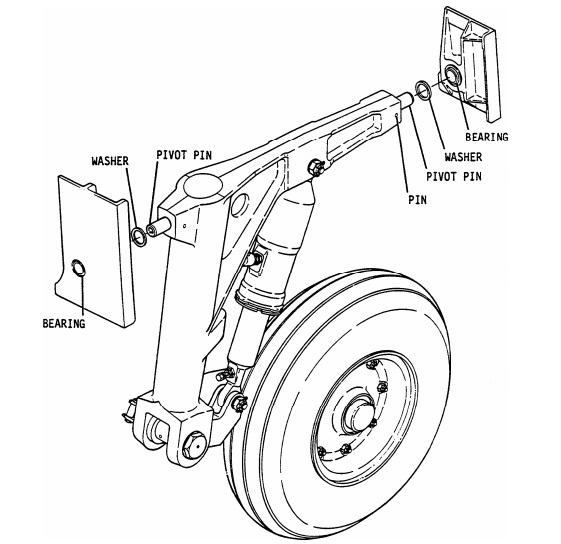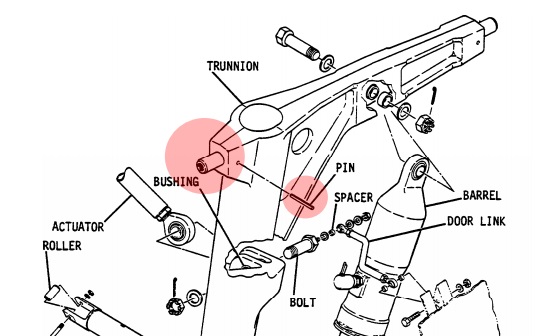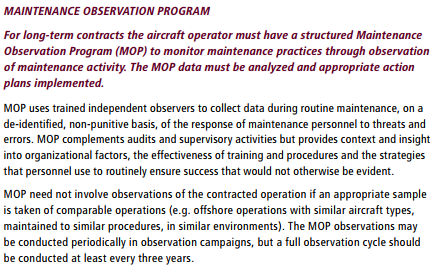Maintenance Human Factors in Finnish F406 Landing Gear Collapse (Lapin Tilauslento F406 Caravan II OH-OTL)
The collapse of a landing gear leg on landing was linked to the mispositioned pivot pin during prior maintenance. This was not detected during an independent inspection or a functional check. Finnish safety investigators discuss the associated maintenance human factors and inadequacies in the type’s maintenance instructions.

Lapin Tilauslento F406 Caravan II OH-OTL at Oulu after MLG Collapse (Credit: Onnettomuustutkintakeskus)
The Accident Flight
A Reims (now ASI) F406 Caravan II, OH-OTL, operated by Lapin Tilauslento Oy, departed for a routine night cargo flight from Rovaniemi to Oulu on 3 October 2016. The Finnish Safety Investigation Authority (SIAF, the Onnettomuustutkintakeskus) describe in their investigation report that:
When the landing gear was retracted, the GEAR UNLOCKED warning light and the HYD PRESS ON indicator for the hydraulic system remained on. At the pilot-in-command’s request, the co-pilot selected gear back down, and the three green lights indicating that the gear was down and locked illuminated normally. The HYD PRESS ON indicator and GEAR UNLOCKED warning were also extinguished as usual.
…procedures directly applicable to this malfunction were not found, but the pilots decided to follow the procedure for cases where the HYD PRESS ON light remained on continuously. The procedure assisted in isolating the fault to the landing gear system, but the exact nature of the malfunction was not clear. The pilots took the actions as instructed, except that the point ”landing gear switch – rapidly recycle” was omitted, since the gear was already extended and the indicator lights showed that it was down and locked.
The crew continued the short flight with the gear down.
…the landing run was normal at first. When the plane had decelerated to a speed of about 60 kt, the pilot-in-command started braking, at which time the right main landing gear collapsed and the aircraft tilted to the right.
The aircraft was “significantly damaged” in the area between the right propeller and the inner right hand flap.
The two crew were uninjured and the runway was closed for 3 hours while the aircraft was moved using pneumatic lifting bags and a transport platform.
The Maintenance History
The Onnettomuustutkintakeskus say:
Immediately before the accident flight, the aircraft had been subjected to phase 20 and phase 21 inspections of both main landing gears, for which the gear must be removed.
The Licenced Aircraft Engineer who performed the task had gained his licence in 1979, held an EASA Part 66 B1/B2 License…
…but was carrying out this particular maintenance action for the first time.
According to his own report he was alert, and the maintenance environment and the tools used were appropriate and suitable for the task. He did not feel as being under a time pressure.
The landing gear casing has two, removable Pivot Pins, fore and aft, completing the trunnion around which the landing gear rotates when it is retracted.
The Pivot Pins are secured by Pins inserted through holes in the casing and the Pivot Pins.
The investigators explain that:
When the right landing gear was installed, the forward pivot pin was left too far forward so that the securing pin supposed to go through it was eventually behind the whole pivot pin.
As a result of the incorrect installation, nothing prevented the pivot pin from moving forward and out of the gear trunnion.
The securing pin was put in place and a safety wire was installed through it. According to the mechanic that made the installation, he used a punch tool to make sure that the securing hole for the pivot pin was in the right place. When positioning the pivot pin, he first noticed that the punch did not go through the pivot pin, and repositioned the pin by supporting the trunnion with the other hand and moving the pivot pin with a puller tool at the same time. The punch then went through the hole in the trunnion, from which the mechanic assumed that the hole was correctly positioned and fitted the securing pin. When removing the puller tool from the pivot pin, he did not support the gear trunnion, and because of greater friction it seemed that the pivot pin was locked in place.
[A] landing gear functional test was carried out by cycling the gear up and down several times without problems.
Consequently:
During taxiing from the stand to take-off, the pivot pin was subjected to vibration, which reduced friction and also created forces that made the pin move forward out of its place. The pivot pin separated fully from the landing gear trunnion at the latest when the pilot started braking upon landing.
The investigators identified shortcomings in maintenance data for the F406:
The maintenance instructions are from year 1985, and in many parts, only based on good maintenance practice. For example, the instructions provide no warning of the possibility of incorrect securing pin installation, or advise that the securing should be checked after the pin is fitted, although such a check would be important and easy to perform.
In addition, the order of actions recommended in the instructions is impractical, as they advise to remove the puller tool used for positioning immediately after the securing holes are aligned, before the securing pin is fitted. Unscrewing of the puller tool increases the risk of the pivot pin moving to an incorrect position. Therefore the securing pin should be fitted as soon as the holes are verified to be aligned.
Essential procedures are also missing from the instructions, such as the fitting of the aft pivot pin in general, and the landing gear functional test after installation.
To the maintenance organisation’s credit:
The work documents showed that the installation of both landing gears had been identified as a critical task in maintenance planning, and a double check [i.e. Independent Inspection] had been carried out as required.
However, the double check did not specifically focus on the fitting of the pivot pin. …only a general visual inspection was made.
Nevertheless, the maintenance organisation had understood that functional test of the landing gear would be appropriate after such maintenance.
This shows that the organisation had the ability to independently identify risks and to strive to work in a correct manner. It was observed that the organisation uses the risk assessment process in an active and documented way to supplement maintenance instructions when they are found inadequate.
Further AcciMap Analysis
The investigators prepared an AcciMap to structure their analysis of the accident:
They explain that:
The AcciMap Approach is used in analysing contributing factors, finding the most important conclusions as well as for preparing effective safety recommendations and targeting them to the right entities.
The accident is depicted as a chain of events at the bottom of the AcciMap graph. Identified decision-makers and other levels that guide action are marked on the left side. The different elements of the chain of events are shown as a bottom-to-top sequence. The lower part of the graph portrays an assessment of the individual accident which is being studied, from which the process leads to wider perspectives and implications, for example, at the national or international level.
Source for the Accimap procedure: J.Rasmussen and I.Svedung, 2000, Proactive Risk Management in a Dynamic Society, Swedish Rescue Services Agency, Karlstad, Sweden.
The Onnettomuustutkintakeskus Probable Cause
The accident was caused by an installation error in the right main landing gear. Checks made during installation were inadequate, and even the final inspection of the work did not cover the correct fitting or securing of the pivot pin.
The pivot pin installation procedure is not complex, and the principle is easy to understand. Working conditions were good and the mechanic who fitted the pin was fairly experienced, so a clear and explicit cause for the error could not be determined. Even though this phase of installation was important structurally and for flight safety, one significant possibility may be that the mechanic’s concentration was not focused on the seemingly simple task.
A contributing factor to the error was that the maintenance instructions did not adequately support the correct performance and quality assurance of the work.
Safety Recommendations
Firstly, the Safety Investigation Authority recommends that the European Aviation Safety Agency (EASA):
…require the aircraft type certificate holder to review and update the maintenance instructions for Reims F406 aircraft, so that any deficiencies in the main landing gear installation instructions are rectified. The landing gear installation instructions do not cover all the necessary phases of work, and the order of phases is impractical in some places. Installation instructions for the pivot pin also provide no warning of the possibility of incorrect installation.
Immediately before the flight in question, the aircraft had undergone scheduled landing gear maintenance in which the main landing gear had been detached from the aircraft. An installation error was made when reattaching the right landing gear during maintenance. Checks made during installation were inadequate, and even the final inspection of the work did not cover the correct fitting or securing of the pivot pin. Incorrect or insufficient instructions do not adequately support the performance of the work. The risk of maintenance errors increases and flight safety is compromised.
Secondly, the Safety Investigation Authority recommends that the Federal Aviation Administration (FAA) of the United States:
…require the aircraft type certificate holder to review and, where necessary, update the maintenance instructions for the Cessna404 and any other aircraft types with a trailing-link landing gear, so that any deficiencies found in the main landing gear installation instructions are rectified. It is possible that the landing gear installation instructions do not cover all the necessary phases or work and that the order of phases is impractical in some places.
The Reims F406 aircraft type is based on the Cessna 404. Both aircraft have the same landing gear construction, and maintenance instructions may also be partly the same. The same landing gear model may also have been used in other aircraft types manufactured by Cessna.
Safety Resources
Aerossurance worked with the Flight Safety Foundation (FSF) to create a Maintenance Observation Program (MOP) requirement for their contractible BARSOHO offshore helicopter Safety Performance Requirements to help learning about routine maintenance and then to initiate safety improvements:
Aerossurance can provide practice guidance and specialist support to successfully implement a MOP.
Aerossurance has previously written about a number of relevant safety, maintenance human factors and continuing airworthiness issues:
- Aircraft Maintenance: Going for Gold?
- Professor James Reason’s 12 Principles of Error Management
- Critical Maintenance Tasks: EASA Part-M & -145 Change
- Maintenance Personnel Fatigue and Alertness
- How To Develop Your Organisation’s Safety Culture
- Fatal $16 Million Maintenance Errors
- Inadvertent Fire Bottle Discharge During Maintenance
- FOD Damages 737 Flying Controls
- Cessna Citation Excel Controls Freeze
- B767 Engine Fire – Ignition from Misrouted / Chaffed Cables
- A319 Double Cowling Loss and Fire – AAIB Report
- Loose B-Nut: Accident During Helicopter Maintenance Check Flight
- USAF RC-135V Rivet Joint Oxygen Fire
- The Missing Igniters: Fatigue & Management of Change Shortcomings
- Misassembled Anti-Torque Pedals Cause EC135 Accident
- EC130B4 Accident: Incorrect TRDS Bearing Installation
- Airworthiness Matters: Next Generation Maintenance Human Factors
- Director of Maintenance Pleads Guilty To Obstructing an NTSB Air Accident Investigation
- Cessna 208 Forced Landing: Engine Failure Due To Re-Assembly Error
- Insecure Pitch Link Fatal R44 Accident
- Bell 429 TR Pitch Change Link Bearing Failure
Another landing gear task prone to misadjustment is discussed by the UK AAIB: AAIB investigation to Cessna 402B, G-MAPP: Left main landing gear collapsed during landing roll, East Midlands Airport, 14 January 2016
In another case, reported by the NASA ASRS scheme in Callback 448, difficulty printing out Maintenance Manual extracts and interpreting them contributed to a maintenance error replacing a seal on a Bombardier CRJ200, that also was not caught by a functional check:
[Another] Aircraft Maintenance Technician and I were installing a new carbon seal on the Integrated Drive Generator (IDG) on Engine #1. During that process, we put a seal in the wrong location. We misinterpreted the diagram depicting where the seal went. Throughout this process we had to keep going back to the [Maintenance] Manual to print out sub-tasks using computers that were exceptionally slow, as well as endure many interruptions…which added to our distraction.
After installation, we performed the leak check in accordance with the Maintenance Manual, and there were no leaks, so we did not realize our error at the time. During discussion about the project, Supervisors found that we had incorrectly installed the seal. By the time we discovered this fact, it was the following day.… The aircraft [had] lost the oil on the left engine IDG, most likely due to our mistake. The aircraft subsequently had to return to base.
It was easy to misinterpret the diagram in the Maintenance Manual. The interruptions due to slow network access to the online Maintenance Manual and [other] interruptions added to the situation.
UPDATE 11 February 2018: Lost in Translation: Misrigged Main Landing Gear
UPDATE 24 June 2018: B1900D Emergency Landing: Maintenance Standards & Practices The TSB report posses many questions on the management and oversight of aircraft maintenance, competency and maintenance standards & practices. We look opportunities for forward thinking MROs to improve their maintenance standards and practices.
UPDATE 25 August 2018: Crossed Cables: Colgan Air B1900D N240CJ Maintenance Error On 26 August 2003 a B1900D crashed on take off after errors during flying control maintenance. We look at the maintenance human factor safety lessons from this and another B1900 accident that year.
UPDATE 3 November 2018: A Lufthansa MD-11F Nose Wheel Detached after Maintenance Error
UPDATE 13 November 2018: Inadequate Maintenance, An Engine Failure and Mishandling: Crash of a USAF WC-130H: investigators discuss a strong cultural overtone in this accident that killed 9.
UPDATE 18 December 2018: USAF Engine Shop in “Disarray” with a “Method of the Madness”: F-16CM Engine Fire
UPDATE 27 December 2018: Inadequate Maintenance at a USAF Depot Featured in Fatal USMC KC-130T Accident
UPDATE 30 March 2019: Contaminated Oxygen on ‘Air Force One’ Poor standards at a Boeing maintenance facility resulted in contamination of two oxygen systems on a USAF Presidential VC-25 (B747).
UPDATE 31 May 2019: The Portuguese accident investigation agency, GPIAAF, issued a safety investigation update on a serious in-flight loss of control incident involving Air Astana Embraer ERJ-190 P4-KCJ that occurred on 11 November 2018. The aircraft was landed safely after considerable difficulty, so much so the crew had debated ditching offshore. GPIAAF conformed that incorrect ailerons control cable system installation had occurred in both wings during a maintenance check conducted in Portugal.
GPIAFF note that: “By introducing the modification iaw Service Bulletin 190-57-0038 during the maintenance activities, there was no longer the cable routing and separation around rib 21, making it harder to understand the maintenance instructions, with recognized opportunities for improvement in the maintenance actions interpretation”. They also comment that: “The message “FLT CTRL NO DISPATCH” was generated during the maintenance activities, which in turn originated additional troubleshooting activities by the maintenance service provider, supported by the aircraft manufacturer. These activities, which lasted for 11 days, did not identify the ailerons’ cables reversal, nor was this correlated to the “FLT CTRL NO DISPATCH” message.”
GPIAFF comment “deviations to the internal procedures” occurred within the maintenance organisation that “led to the error not being detected in the various safety barriers designed” in the process. They also note that the error ” was not identified in the aircraft operational checks (flight controls check) by the operator’s crew.”
UPDATE 1 June 2019: Our analysis: ERJ-190 Flying Control Rigging Error
UPDATE 28 April 2020: Beech 99A MLG Collapse
UPDATE 3 June 2020: Beechcraft 1900C Landing Gear Collapse at San Antonio, TX
UPDATE 16 June 2020: CRJ-200 Landing Incident Highlighted US Maintenance Competency Inadequacies
UPDATE 23 June 2020: Myanmar National Embraer 190 NLG Jam: Maintenance Error? We’re Not Convinced!
UPDATE 12 October 2020: Frozen Dash 8-100 Landing Gear After ‘Improper Maintenance Practices’ Say NTSB
Aerossurance is pleased to be both sponsoring and presenting at a Royal Aeronautical Society (RAeS) Human Factors Group: Engineering seminar Maintenance Error: Are we learning? to be held on 9 May 2019 at Cranfield University.







Recent Comments